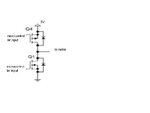jayanthyk192
Full Member level 3
hi,
I building a brushless motor controller using h bridge. the upper side has irf9540 and the lower side has irfz44n. i connected their sources to 5thv and 0v resp. using logic 5v as gate voltage for both I started the brushless motor. it works but the current is not going beyond 200mA.why is this happening. the current at 5v for both is beyond 3A for both.
thank you
I building a brushless motor controller using h bridge. the upper side has irf9540 and the lower side has irfz44n. i connected their sources to 5thv and 0v resp. using logic 5v as gate voltage for both I started the brushless motor. it works but the current is not going beyond 200mA.why is this happening. the current at 5v for both is beyond 3A for both.
thank you
